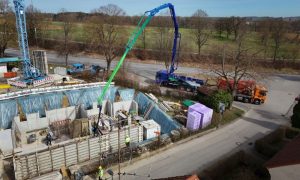Easy lifter
VSL heavy lifting manager ? ME David Gratteau tells us how the company positioned a 280-ton steel truss 51 metres above ground in one smooth operation to form part of U-Bora Towers

Located in Business Bay, Dubai, U-Bora Towers comprises a 56-storey office tower and a curved residential building, rising from 12 storeys at the tower end to 16 storeys at the western end.
It is being developed by Korean company Bando, alongside Abu Dhabi Commercial Bank (ADCB), architecture firm Aedas and property services company Asteco.
Last month, VSL lifted a 280-ton pre-fabricated, reinforced steel truss comprising beams and pipe bracings into place to form a cut-out square archway in the residence building. VSL heavy lifting manager — Middle East David Gratteau tells us how they did it:
"The conventional method would be to use a crane; build a temporary platform and progressively and slowly assemble the steel members until the completion of the truss. However, there are various problems with this method.
Building a temporary platform at height is not easy, it takes time to install and can be costly. Furthermore, the weight of the steel is around 280 tons and the podium below limits the crane access. "Instead, we used the strand jacking method to lift the steel extrusion. This method allows the load to be picked up at each connection point. The complete truss can be assembled at ground level and the VSL lifting jacks, situated one floor above the final level of the truss (in this case, 55 metres up) lift and place the load in one single operation.
"The truss was not bolted to the side buildings, but was sitting on corbels. We lifted the truss with a side offset of 1.8 metres until the final level (plus 10cm), then with push-pull jacks, we slid the lifting strand jacks and truss horizontally by 1.8 metres and then lowered the load onto its definitive supports, progressively transferring it to the permanent structure.
"Heavy lifting is a cost-effective solution and works out cheaper than other conventional methods.
"Assembly at ground level is quicker than at height and results in a higher quality of construction. This cuts the cost of staffing and reduces rental periods for equipment, such as propping and scaffolding. Furthermore, smaller machines and cranes are required."



















